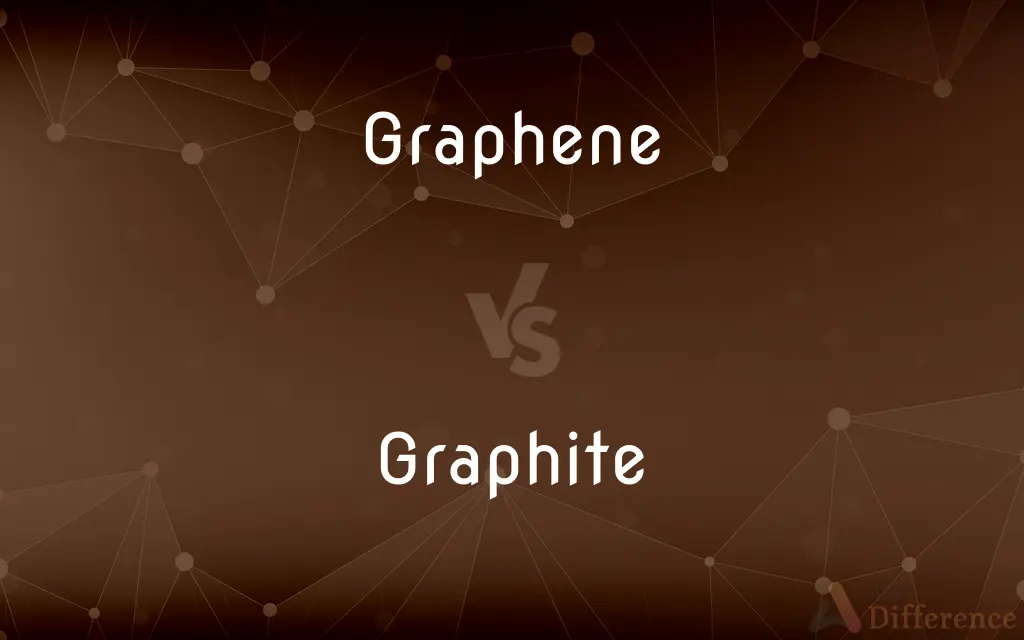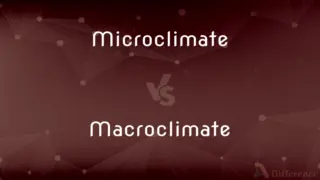Graphene vs. Graphite — What's the Difference?
By Urooj Arif & Fiza Rafique — Updated on March 24, 2024
Graphene is a single layer of carbon atoms in a hexagonal lattice, while graphite is composed of many graphene layers stacked together.

Difference Between Graphene and Graphite
Table of Contents
ADVERTISEMENT
Key Differences
Graphene, a single layer of carbon atoms arranged in a hexagonal lattice, exhibits remarkable electrical, thermal, and mechanical properties. It's known for its strength, flexibility, and conductivity. Graphite, on the other hand, consists of multiple layers of graphene stacked together, which gives it a different set of characteristics. It's a good lubricant, conducts electricity, and is used in pencils and as a moderator in nuclear reactors.
While graphene is essentially two-dimensional, giving it unique quantum mechanical properties, graphite is a three-dimensional material. This structural difference impacts their electrical conductivity, with graphene exhibiting higher conductivity than graphite due to its structure allowing electrons to move more freely.
Graphene's strength is derived from its two-dimensional, one-atom-thick structure, making it one of the strongest materials known. Graphite, while still strong, is weaker between its layers, allowing them to slide over each other easily, which is why it feels slippery and is used as a lubricant.
In terms of applications, graphene's potential uses are wide-ranging and include electronics, medical devices, and energy storage. Graphite, while also versatile, is currently used in batteries, brake linings, and as a lubricant. The development of graphene-based technologies could significantly impact various industries.
Graphene's production methods are evolving, including chemical vapor deposition and mechanical exfoliation, aiming for high-quality, large-area sheets. Graphite is mined and then processed into various grades and forms, depending on its intended use, with natural and synthetic sources.
ADVERTISEMENT
Comparison Chart
Structure
Single layer of carbon atoms in hexagonal lattice
Multiple layers of graphene stacked
Electrical Conductivity
Very high, due to free-moving electrons
Less than graphene, hindered by layering
Strength
Extremely strong, one of the strongest known materials
Strong, but weaker between layers
Applications
Electronics, energy storage, medical devices
Lubricants, batteries, brake linings
Production
Chemical vapor deposition, mechanical exfoliation
Mined, processed from natural or synthetic sources
Compare with Definitions
Graphene
Conducts electricity and heat efficiently.
Graphene is being studied for potential use in transparent conductive films for touchscreens.
Graphite
Composed of stacked layers of graphene.
The layers in graphite allow it to be used as a lubricant, where they slide over each other.
Graphene
Potential for high-capacity energy storage.
Graphene-based batteries may significantly outperform current lithium-ion technology.
Graphite
Used in pencils and as a lubricant.
The softness of graphite makes it ideal for use in pencils.
Graphene
A single layer of carbon atoms in a hexagonal lattice.
Scientists are exploring graphene for use in advanced electronics due to its exceptional conductivity.
Graphite
Good electrical conductor.
Graphite is used in electrodes because it conducts electricity well.
Graphene
Flexible and transparent.
Flexible, transparent graphene sheets are promising for future wearable technology.
Graphite
Can withstand high temperatures.
Graphite is utilized in high-temperature applications due to its thermal stability.
Graphene
Known for its strength and flexibility.
Graphene could revolutionize the materials industry, being both incredibly strong and lightweight.
Graphite
Available in natural and synthetic forms.
Synthetic graphite is produced for specific industrial applications requiring purity.
Graphene
Graphene () is an allotrope of carbon consisting of a single layer of atoms arranged in a two-dimensional honeycomb lattice. The name is derived from "graphite" and the suffix -ene, reflecting the fact that the graphite allotrope of carbon contains numerous double bonds.
Graphite
Graphite (), archaically referred to as plumbago, is a crystalline form of the element carbon with its atoms arranged in a hexagonal structure. It occurs naturally in this form and is the most stable form of carbon under standard conditions.
Graphene
A monolayer of carbon atoms having a hexagonal lattice structure and constituting a basic structural element of graphite, fullerenes, and carbon nanotubes.
Graphite
A soft crystalline allotrope of carbon, composed of graphene layers, having a steel-gray to black metallic luster and a greasy feel, used in lead pencils, lubricants, paints and coatings, and fabricated into a variety of forms such as molds, bricks, electrodes, crucibles, and rocket nozzles. Also called black lead, plumbago.
Graphene
(organic chemistry) Any polycyclic aromatic hydrocarbon having the structure of part of a layer of graphite.
Graphite
An allotrope of carbon, consisting of planes of carbon atoms arranged in hexagonal arrays with the planes stacked loosely, that is used as a dry lubricant, in "lead" pencils, and as a moderator in some nuclear reactors.
Graphene
(inorganic chemistry) An arbitrarily large-scale, one-atom-thick layer of graphite, an allotrope of carbon, that has remarkable electric characteristics.
Graphite
Short for graphite-reinforced plastic, a composite plastic made with graphite fibers noted for light weight strength and stiffness.
Modern tennis racquets are made of graphite, fibreglass and other man-made materials.
Graphite
A grey colour, resembling graphite or the marks made with a graphite pencil.
Graphite
(transitive) To apply graphite to.
Graphite
Native carbon in hexagonal crystals, also foliated or granular massive, of black color and metallic luster, and so soft as to leave a trace on paper. It is used for pencils (improperly called lead pencils), for crucibles, and as a lubricator, etc. Often called plumbago or black lead.
Graphite
Used as a lubricant and as a moderator in nuclear reactors
Common Curiosities
Can graphene conduct electricity better than graphite?
Yes, graphene conducts electricity better than graphite because its structure allows electrons to move more freely.
What is graphite?
Graphite is a mineral consisting of stacked layers of graphene, used in various applications due to its electrical conductivity and lubricating properties.
What are the main uses of graphene?
Graphene is explored for uses in electronics, medical devices, energy storage, and more due to its unique properties.
What is graphene?
Graphene is a single layer of carbon atoms arranged in a hexagonal lattice, known for its extraordinary electrical, thermal, and mechanical properties.
How is graphene produced?
Graphene is produced through methods like chemical vapor deposition and mechanical exfoliation.
How is graphite obtained?
Graphite is mined and then processed from natural or synthetic sources, depending on the application.
What is the impact of graphene on energy storage technologies?
Graphene could significantly improve energy storage technologies by enabling batteries with higher capacity and faster charging times.
Can graphite be used in flexible electronics?
While graphite itself is not used in flexible electronics, graphene, derived from graphite, holds potential for such applications due to its flexibility.
How do graphene and graphite differ in structure?
Graphene is a two-dimensional, one-atom-thick structure, whereas graphite is made up of many graphene layers stacked together.
Why is graphene considered stronger than graphite?
Graphene is considered one of the strongest materials known due to its two-dimensional, one-atom-thick structure, unlike graphite, which is weaker between its layers.
Is graphite naturally occurring?
Yes, graphite is a naturally occurring form of carbon, though synthetic graphite can also be produced.
What are the main uses of graphite?
Graphite is used in lubricants, batteries, brake linings, and as a moderator in nuclear reactors, among other applications.
How does the lubricating property of graphite work?
The lubricating property of graphite comes from its layered structure, allowing layers to slide over each other easily, reducing friction.
Why is graphene considered revolutionary?
Due to its unique combination of strength, conductivity, and flexibility, graphene has the potential to revolutionize various industries.
How do the thermal properties of graphene and graphite compare?
Both graphene and graphite have high thermal conductivity, but graphene's two-dimensional structure offers potentially higher efficiency.
Share Your Discovery

Previous Comparison
Microclimate vs. Macroclimate
Next Comparison
Teppanyaki vs. TeriyakiAuthor Spotlight
Written by
Urooj ArifUrooj is a skilled content writer at Ask Difference, known for her exceptional ability to simplify complex topics into engaging and informative content. With a passion for research and a flair for clear, concise writing, she consistently delivers articles that resonate with our diverse audience.
Co-written by
Fiza RafiqueFiza Rafique is a skilled content writer at AskDifference.com, where she meticulously refines and enhances written pieces. Drawing from her vast editorial expertise, Fiza ensures clarity, accuracy, and precision in every article. Passionate about language, she continually seeks to elevate the quality of content for readers worldwide.















































